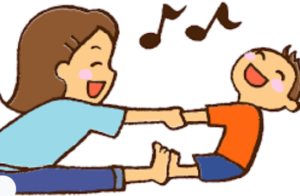Authored by:

Laura Cirelli
Laura Cirelli is an Assistant Professor of Psychology at the University of Toronto Scarborough. Laura studies how engaging in musical activities can be a social and emotional experience for infants and young children. She studied at Laurentian University, received her PhD from McMaster University and completed a postdoctoral fellowship at the University of Toronto before starting her faculty position.
How do young siblings use music together in play, and what does this teach us about why music is an important part of our everyday lives across the lifespan?
Mothers sing soft lullabies to their newborns, toddlers start to clap along to their favourite songs and preschoolers sing together on the playground – musical interactions are a salient part of everyday life in early childhood. Indeed, musical interactions continue to be important across the lifespan. We invest billions of dollars worldwide into the music industry, and the average person spends the equivalent of 13 years of their life listening to music!
So why do we invest so much time and energy into musical activities, and why do they become an important part of our everyday lives? Music psychologists, ethnomusicologists, and even evolutionary scientists have presented a variety of ideas about the origin of human musical behaviours. One compelling idea is that music is socially adaptive. Music connects us, socially and emotionally. In the current global pandemic, we have already witnessed this power of music from neighbours singing together across balconies to pop stars raising hundreds of millions of dollars for coronavirus relief through livestreamed benefit concerts.

Early musical interactions encourage prosociality even in infancy
One important prediction in the social bonding hypothesis for musical behaviour is that making music with others will encourage prosociality (e.g. things like sharing, helping, cooperating, and affiliation). My early research found evidence supporting this prediction with children as young as 14 months of age.
Toddlers who visited the lab were held by an assistant in a forward-facing infant carrier. The assistant gently bounced them to the beat of “Twist and Shout” playing in the background. The experimenter facing the child either bounced in synchrony or out of synchrony with the child. When the song ended, the toddlers were put in a situation where the experimenter needed their help in order to complete simple tasks. More specifically, she would do things like draw a picture, but “accidentally” drop the marker she was using so that it was out of reach.
On a series of tasks infants had a number of opportunities to help this experimenter by handing her these needed out-of-reach objects. Amazingly, toddlers would help their synchronous partner more. In fact, after just two and a half minutes of moving in synchrony with this person, infants would hand back more than 50% of the dropped objects. This was significantly higher than the rate of helping by infants interacting with an out-of-sync mover (just over 20%). Moving in synchrony is an important feature of musical engagement. If you and I dance to the same song, we align our movements to the beat of the song, and will soon find that our movements are aligned with each other, as well.
Researchers have continued to document this link between early musical interactions and social behaviour. Laboratory studies have shown that when two school-age children play together in a synchronous musical way, they are later more likely to help one another complete a task cooperatively rather than competitively, and feel more similar and connected to each other. There is even new evidence to suggest that synchronous movement may mitigate negative racial biases and connect people across group divisions.
From this research, we still don’t know whether music is simply a good “ice breaker” or if musical tendencies have a more lasting relationship with prosociality. In laboratory studies with children and adults, musical interactions usually involve two strangers. Can musical interactions shape prosociality directed toward individuals who already have a relationship? Do spontaneous, everyday musical behaviours also have social implications? Could individuals who are already more prosocial also be more likely to integrate musical activities into their everyday lives?
Musical play and prosociality in a naturalistic context
As the director of the TEMPO lab at the University of Toronto Scarborough I wanted to explore these questions. In the TEMPO lab, we are interested in the development of music perception and cognition, and the social implications of early musical experiences.
Recently, in collaboration with my colleagues at Concordia University and the University of Waterloo, we analyzed musical behaviours and prosociality in naturalistic sibling interactions and published these results in Social Development.
We wanted to study natural, spontaneous interactions between siblings. Luckily, previous researchers had been interested in these relationships, especially in the context of understanding sibling aggression. Researchers from the University of Waterloo had previously collected data from 39 sibling pairs from middle-class Canadian families in order to look at sibling aggression. Home recordings were collected over six 90-min sessions at time 1, when the children were 2 and 4 years of age, and again over six 90-min sessions at time 2, when the children were now 4 and 6 years of age.
We reanalyzed the transcripts from these visits to document incidences of prosociality and musical play. Examples of prosociality included events where one sibling would express a need (either verbally or nonverbally) and the other sibling would address their need by helping, sharing, or comforting. Musical play was identified whenever one or both siblings engaged in dance, instrument playing, singing, or music listening.
How often did siblings engage in musical play?
The first thing we wanted to explore was whether musical play was a common part of naturalistic sibling interactions. And it was! In about 700 hours of recording across the 39 dyads, almost 1500 instances of musical play were noted. For example, children made up songs, danced and clapped, and played air guitar. All dyads displayed musical play at least once, and some siblings used music a lot (one dyad had 99 musical play events at time 2!). In general, siblings used musical play more at time 2 (30 times per dyad on average) than at time 1 (almost 8 times per dyad on average). Dancing and singing showed the most dramatic increases in prevalence from time 1 (when children were 2 and 4 years old) to time 2 (when children were 4 and 6 years old). This highlights that musical play is a frequent part of everyday life for young children as they interact with their siblings, and that it becomes more prevalent as children enter preschool years.
Did birth order affect musical play?
The way that this data was collected also allowed us to ask new questions about whether birth order has any impact on musical play behaviours. More specifically, at time 1 the older siblings were 4 years old, and at time 2 the younger siblings were 4 years old. By comparing first-born siblings at time 1 to second-born siblings at time 2, we can control for effects of age.
When doing this, we found that first-born children at age 4 were more likely to initiate joint music making while second-born children at age 4 were more likely to engage in solo singing and solo dancing. This birth order effect highlights the importance of social context on musical play. First born older siblings are more likely to start singing or dancing and then entice their younger sibling into this game.
This increased initiation of joint music making fits well within other literature on sibling dynamics suggesting that first-borns often guide and control sibling interactions. Our results also suggest that the musical behaviours of second-borns may be scaffolded by their older siblings. We know from previous research that between the ages of two and six, dancing and singing become increasingly complex and accurate. Having an older playmate to demonstrate advanced musical play may motivate second-born children to practice their developing musical skills. Older siblings are also likely to bring new songs and musical games from preschool and daycare back to the home, exposing their younger siblings to their richer repertoire at an earlier age.
Links between sibling musical play and prosociality
Finally, and most importantly for the present study, we explored the relationship between musical play and sibling prosociality. At time 1, when the siblings were 2 and 4 years old, the older sibling’s prosociality was positively correlated with frequency of older sibling musical play. Specifically, more musical older siblings were also more likely to help, share, and comfort their little brother or sister when needed. Relatedly, at time 2, when children were 4 and 6 years old, older sibling musical play was positively correlated with both older and younger sibling prosociality. That is, the 6-year-olds who were the most musical were also likely to help, share and comfort their younger sibling and to be helped, shared and comforted by their younger sibling when needed.
Take home points
These results suggest that musical play is prevalent in early sibling interactions, and highlight that naturalistic home recordings can reveal rich insights into everyday music making. They also reinforce the potential link between music making and social behaviour.
However, a word of caution is warranted when interpreting correlational results such as these. It is exciting to learn that the older siblings who were more musical also displayed more prosociality but we have to be careful not to infer causality. That is, we do not know if music making leads children to be more prosocial, if more prosocial children are also more interested in musical play, or if some third unmeasured variable can account for both increased musical play and increased prosociality (for example, the quality of the sibling relationship). These findings are consistent with the idea that music is social, but future research is needed to further understand the complex interplay between music and prosociality.
What are the implications for educators?
As educators, you likely witness and initiate naturalistic musical behaviours all the time in the classroom. The clean-up song may chorus through the classroom as children put away toys before the next lesson. Children sing songs and skip together at recess. Music can even be used as an educational tool (i.e. singing the ABCs). Research like this highlights that music may be an especially important social tool for children.
We do not need to be musical professionals to enjoy everyday music making activities with others. Some of my other research has shown that musical movement is also related to joy – when children dance more, they smile more! Using music to capture a class’ attention, engage them in a common goal, and encourage them to pay attention to their peers may be a powerful (and affordable!) way to help students feel more connected to one another. The birth-order findings in this sibling study also highlight the potential for older children to scaffold younger children.
When we think of music in the classroom, we often intuitively think of formal music training. Certainly, music training is a rewarding endeavour in its own right. But hopefully this research can direct your attention to the ways in which informal experiences of spontaneous musical play in childhood may have lasting social-emotional implications.
[A .pdf version of this article is available for download here]
Authored by:

Laura Cirelli
Laura Cirelli is an Assistant Professor of Psychology at the University of Toronto Scarborough. Laura studies how engaging in musical activities can be a social and emotional experience for infants and young children. She studied at Laurentian University, received her PhD from McMaster University and completed a postdoctoral fellowship at the University of Toronto before starting her faculty position.
Leave a Reply